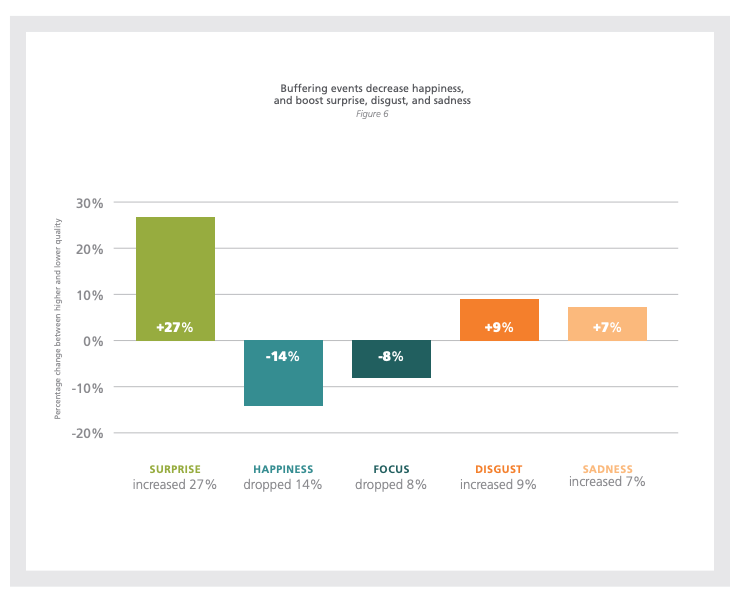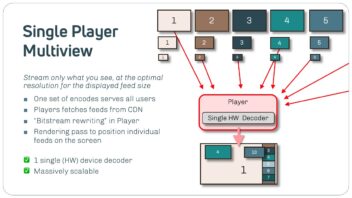Are you crazy? A commercial video player for my sports streaming?
In the rapidly evolving world of sports streaming, every OTT sports streamer faces increasing pressure to deliver high-quality, seamless, and interactive viewing experiences to their viewers. As technology advances, so do viewer expectations, demanding lower latency, multiview, and device-agnostic streaming. Not only do we encouter these request when talking to customers, also industry reports – Ross Video and Mediakind just to mention two – indicate this trend as well as discussions during the DPP summit recently.
More sports are becoming available to fans, which means leagues and clubs must battle for their fan’s engagement, while their fans have a fear of missing out (FOMO) on all the sports they cheer for. This leads to changing and more personalised viewer behavior and demands like a greater choice of camera angles, synchronised graphic elements with statistics, interactions on social channels, keeping an eye on several games, betting, gamification and more. All these new viewer demands make streaming a much more complex business.
A key element in the complex streaming equition is the video player. It is the beating heart of the customer facing application and a decisive factor in important service elements like the quality of experience of the viewer while watching a game. The player has a profound impact on the emotional state of the fan as described in Akamai research and directly impacts revenue where it comes to churn, ad revenue and brand reputation.

Figure 1 Akamai research on the emotional state of a viewer when encountering buffering
As Figure 1 shows, being surprised because of bad video playback is not an emotional plus. Buffering is one of the most impactful elements of QoE for high value sports content according to this paper from 2014 on Roland Garros tennis streaming. It describes a correlation between buffering and user engagement for the semi final of the tennis tournament: a 1% increase in buffering ratio from below 1% to between 1% and 2% dropped the average playtime from 37 minutes to 12 minutes. It indicates that what intuitively makes sense: too much of the buffer icon will frustrate viewers and chase them away. We suspect that in todays subscription and pay-per-view based world with high speed last mile networks the tolerance will be even lower: people pay for content and last-mile connectivity and therefore expect quality.
These changing viewer requirements impact a critical strategic discussion that faces every OTT sports streamer in the industry: which video player solutions fits best with my business? Whether to buy a commercial video player – and how to select the right one? – or (continue to) build your own using open-source alternatives or on top of platform players. It is a decision of vital importance since it will determine the customer facing part of the streaming business for several years, impacting quality of service, available features and cost. There are many considerations that drive this discussion, this blog will list some key aspects influencing a final decision.
1. Innovation and new features 🚀
Modern viewers expect multiview, real-time statistics, instant replays, customizable viewing angles, low-latency streaming and more to keep them engaged. Some viewers may even long for high quality XR streaming. To add these kind of features to an existing open-source-based player or platform player requires significant development time and testing.
Even rather “mundane” developments like better adaptive bitrate streaming, multi-DRM integration, and multi-device compatibility also demand continuous development efforts. Some features are also very hard to build on top of exisiting open-source or platform players because of the technical level of control required. An example of this is co-viewing, where building the logic to keep all users in sync may easily take 20k lines of app level code (this is an actual customer example) on top of an open source player implementation, where a suitable commercial player comes with this feature out of the box.
Then there are some service features are almost impossible to build on top of open source or platform players. A good example of this is personalised multi-camera multiview where all the cameras should be in perfect sync. Some services have implemented multi-camera multiview with multiple video players on top of existing platform players (like AVPlayer of Exoplayer) to enable maximum personalisation for viewers, which is a really cool feature. This implementation however results in a situation where multiple players are competing with each other for bandwidth and device resources, leading to a suboptimal viewer experience.
Such a service is often difficult to roll out cross platform, since not all platforms are capable of spinning up multiple players and have different characteristics. In any case, the amount of players is typically limited to 4 for decent performance. Keeping those players in sync is very hard since only the playback speed can be influenced. In addition, all four players will try to get to their best ABR level irrespective of what the other players are doing leading to suboptimal streaming resolutions and buffering. This blog explains in great detail why a single player solution is more suited for this use case, something that can only be build by controlling everything from the video decoder hardware upward – bypassing existing platform and open-source players.
 F1 TV Premium, an example of single player multiview
F1 TV Premium, an example of single player multiview
2. Technical Debt and Maintenance Burden 🔧
Maintaining and optimizing an open-source-based player creates ongoing technical debt, requiring dedicated resources to debug, patch, and enhance the system. There is also the risk of the open-source project losing traction from developers. A commercial solution shifts this responsibility to the vendor, allowing a service provider’s engineering team to focus on strategic initiatives instead of constant player maintenance.
A big source of maintenance is caused by multi-platform support. With every Android / iOS / Web / SmartTV and other platform upgrades by Google, Apple and other device vendors, the risk of breaking the application and video player is there. New devices with new capabilities are also rolled out, with their own challenges. Changes around DRM policy, ad-insertion technology and analytics mandate a continuous maintenance process, something commercial players have ingrained in their operations
3. Stability and performance 🏆
Live sports streaming demands uncompromising reliability—any disruptions lead to viewer frustration and churn, see the Netflix bout between Mike Tyson and Jake Paul and the following viewer uproar. Commercial players are battle-tested in existing deployments, they have a track record. This will give service providers confidence to deploy in similar environments. With home grown solutions it is hard to compare apples-to-apples since platform and open-source players will be heavily tuned by their service providers to achieve stability and performance, tuning that is not always feeding back into the open-source community.
Key video player performance indicators like start-up time, percentage buffering, percentage errors should be as optimal as possible when viewing valuable (live) sports as was mentioned in the beginning of this blog to keep viewers happy. With platform and open-source players there is only a certain level of control achievable to facilitate this. Also features like casting and airplay that are typically used by viewers should work seamlessly and are notoriously hard to get right because of all the corner cases. A good commercial player should have this covered since corner cases will be known issues faster with more viewers.
4. Costs and long-term expenses 💰
While maintaining an in-house player might appear cost-effective initially, since there is no licensing cost, hidden costs add up over time—including developer salaries, third-party tools, and infrastructure expenses. A commercial player provides predictable pricing with built-in support, reducing unexpected financial strain.

Bitmovin wrote a small blog to quantify the total cost of ownership (TCO) of a build-and-maintain-it-yourself open source player service versus their offering. It illustrates what is intuitively understood: if you can spread maintanance cost across many customers it is cheaper than maintaining a player all by yourself.
5. Support ⚙️
In-house solutions require a service provider’s software engineers to troubleshoot and resolve all issues internally. Those engineers can leverage the open-source community for know-how but often the issues that arise are either commercially sensitive or not at all covered by the open-source player, making their work harder.
A commercial player has the advantage of issues popping up across multiple customers, which in turn leads to quick resolution of those issues and improvement of the player product. It also gives support engineers a good understanding of the customer landscape and the issues they encounter, allowing them to help other customers facing similar issues even better.
So yes, swapping out your player may make sense
Even if you have already invested in building an in-house player, there are several challenges in ahead:
- How to maintain and future proof your in-house player investment?
- How to innovate to support the latest viewer trends?
- How to ensure good quality of experience for your viewers across the board?
- How to keep associated cost manageable and predictable?
Depending on your streaming service service requirements a commercial player would tick all the boxes on above questions. The remaining question then is: which one to choose? And since we wrote this blog, we of course recommend Tiledmedia Player 😊

You may have worked with other vendors than Tiledmedia for your player and decided at some point to take matters in house again because you were not satisfied with the level of support or control over feature development. At Tiledmedia we understand the need for agile response to customers needs and we tend to work as an extension of your application and/or player team. This is a fundamentally different way of working, your streaming service is leading and we try to accommodate your requirements. This is a nice example of how that is perceived by one of our customers.
If you’re running an OTT sports streaming service, your video player is either your biggest asset – or your biggest liability. Viewer expectations are higher than ever, and the wrong player can lead to up to 67% viewer drop-off due to buffering and lost revenue from churn, ad inefficiencies and poor QoE. So why gamble with your tech stack?
At Tiledmedia, we engineered our player from the ground up to eliminate these risks, resulting in:
- A start-up time up to 30% faster than traditional platform players
- Multiview without bandwidth bottlenecks – Fully synchronized multi-camera experiences
- Built-in low-latency and seamless ABR switching – Fewer buffering events, higher viewer retention
- Cross-platform consistency – One player, one codebase, same behaviour across iOS, Android, Web, Smart TV
- Less maintenance, fewer errors, lower TCO – Reduce engineering overhead while scaling effortlessly
See the impact firsthand and get a free trial of Tiledmedia Player today or try out our demo app.
Future-proof your streaming, reduce churn, and maximize engagement – starting from today!
April 2, 2025
Blogs

Author
Frits Klok
Stay tuned!


